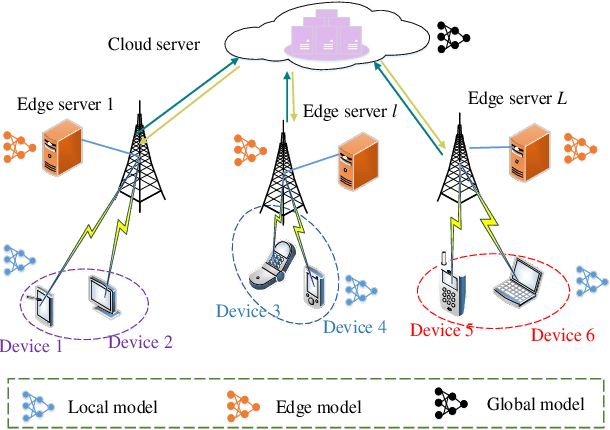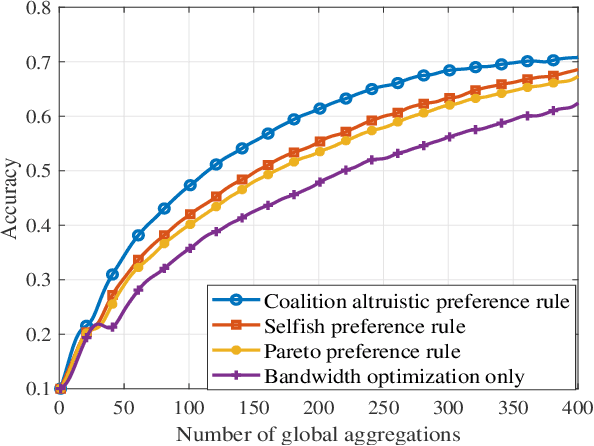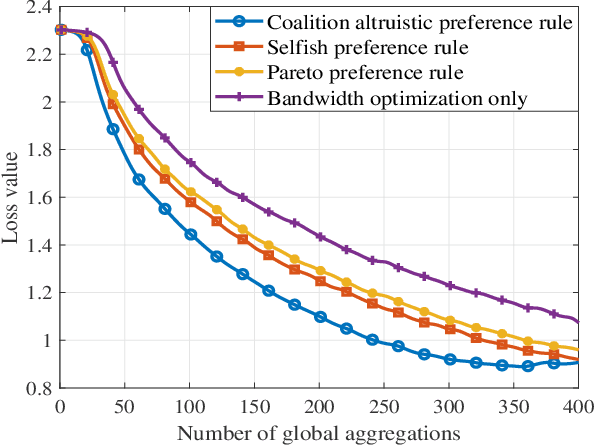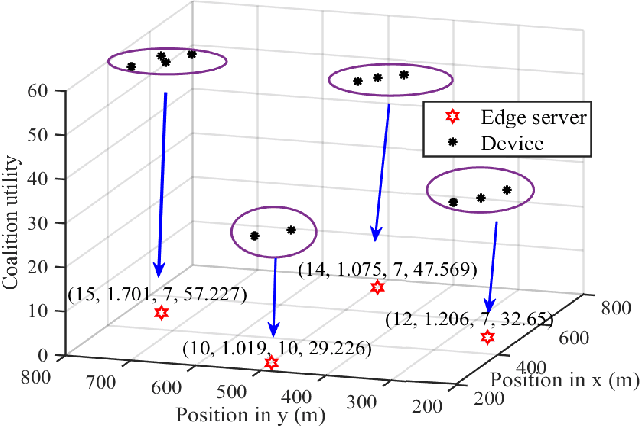Kunlun Wang
Virtual-Real Collaborated Split Learning via Model Partitioning in IRS-Assisted IoT Networks
Oct 30, 2025Abstract:This paper investigates a novel computation and communication co-design framework for large-scale split learning in intelligent reflecting surface (IRS)-assisted internet of things (IoT) networks integrated with digital twin (DT) technique. The considered system consists of a multi-antenna access point (AP), multiple heterogeneous user devices (UDs), and an deployed IRS to enhance both uplink and downlink transmission. The training process of a deep neural network is partitioned between devices and the AP, where a DT replica is activated to replace UDs with insufficient local computation capabilities. We formulate a delay-optimal split learning problem, which optimizes five key variables: layer partitioning points, DT assignment decisions, IRS phase shift matrix, AP downlink power allocation, and DT frequency adjustment, aiming to minimize the overall end-to-end delay under communication and computation. The proposed optimization problem is a highly coupled non-convex mixed-integer problem. Therefore, we solve using an alternating optimization approach combining closed-form updates, semidefinite relaxation (SDR), and low-complexity heuristics. Extensive simulations demonstrate that the proposed scheme significantly reduces training delay compared to conventional baselines and achieves up to 35\% delay improvement, especially under high UD density and stringent power constraints.
Vehicular Multi-Tier Distributed Computing with Hybrid THz-RF Transmission in Satellite-Terrestrial Integrated Networks
Jan 26, 2025Abstract:In this paper, we propose a Satellite-Terrestrial Integrated Network (STIN) assisted vehicular multi-tier distributed computing (VMDC) system leveraging hybrid terahertz (THz) and radio frequency (RF) communication technologies. Task offloading for satellite edge computing is enabled by THz communication using the orthogonal frequency division multiple access (OFDMA) technique. For terrestrial edge computing, we employ non-orthogonal multiple access (NOMA) and vehicle clustering to realize task offloading. We formulate a non-convex optimization problem aimed at maximizing computation efficiency by jointly optimizing bandwidth allocation, task allocation, subchannel-vehicle matching and power allocation. To address this non-convex optimization problem, we decompose the original problem into four sub-problems and solve them using an alternating iterative optimization approach. For the subproblem of task allocation, we solve it by linear programming. To solve the subproblem of sub-channel allocation, we exploit many-to-one matching theory to obtain the result. The subproblem of bandwidth allocation of OFDMA and the subproblem of power allocation of NOMA are solved by quadratic transformation method. Finally, the simulation results show that our proposed scheme significantly enhances the computation efficiency of the STIN-based VMDC system compared with the benchmark schemes.
Movable Antenna Enhanced Networked Full-Duplex Integrated Sensing and Communication System
Nov 14, 2024



Abstract:Integrated sensing and communication (ISAC) is envisioned as a key technology for future sixth-generation (6G) networks. Classical ISAC system considering monostatic and/or bistatic settings will inevitably degrade both communication and sensing performance due to the limited service coverage and easily blocked transmission paths. Besides, existing ISAC studies usually focus on downlink (DL) or uplink (UL) communication demands and unable to achieve the systematic DL and UL communication tasks. These challenges can be overcome by networked FD ISAC framework. Moreover, ISAC generally considers the trade-off between communication and sensing, unavoidably leading to a loss in communication performance. This shortcoming can be solved by the emerging movable antenna (MA) technology. In this paper, we utilize the MA to promote communication capability with guaranteed sensing performance via jointly designing beamforming, power allocation, receiving filters and MA configuration towards maximizing sum rate. The optimization problem is highly difficult due to the unique channel model deriving from the MA. To resolve this challenge, via leveraging the cutting-the-edge majorization-minimization (MM) method, we develop an efficient solution that optimizes all variables via convex optimization techniques. Extensive simulation results verify the effectiveness of our proposed algorithms and demonstrate the substantial performance promotion by deploying MA in the networked FD ISAC system.
Device Scheduling for Relay-assisted Over-the-Air Aggregation in Federated Learning
Dec 15, 2023



Abstract:Federated learning (FL) leverages data distributed at the edge of the network to enable intelligent applications. The efficiency of FL can be improved by using over-the-air computation (AirComp) technology in the process of gradient aggregation. In this paper, we propose a relay-assisted large-scale FL framework, and investigate the device scheduling problem in relay-assisted FL systems under the constraints of power consumption and mean squared error (MSE). we formulate a joint device scheduling, and power allocation problem to maximize the number of scheduled devices. We solve the resultant non-convex optimization problem by transforming the optimization problem into multiple sparse optimization problems. By the proposed device scheduling algorithm, these sparse sub-problems are solved and the maximum number of federated learning edge devices is obtained. The simulation results demonstrate the effectiveness of the proposed scheme as compared with other benchmark schemes.
On the Performance of RIS-Aided Spatial Scattering Modulation for mmWave Transmission
Aug 31, 2023



Abstract:In this paper, we investigate a state-of-the-art reconfigurable intelligent surface (RIS)-assisted spatial scattering modulation (SSM) scheme for millimeter-wave (mmWave) systems, where a more practical scenario that the RIS is near the transmitter while the receiver is far from RIS is considered. To this end, the line-of-sight (LoS) and non-LoS links are utilized in the transmitter-RIS and RIS-receiver channels, respectively. By employing the maximum likelihood detector at the receiver, the conditional pairwise error probability (CPEP) expression for the RIS-SSM scheme is derived under the two scenarios that the received beam demodulation is correct or not. Furthermore, the union upper bound of average bit error probability (ABEP) is obtained based on the CPEP expression. Finally, the derivation results are exhaustively validated by the Monte Carlo simulations.
RIS-Aided Spatial Scattering Modulation for mmWave MIMO Transmissions
Jul 27, 2023



Abstract:This paper investigates the reconfigurable intelligent surface (RIS) assisted spatial scattering modulation (SSM) scheme for millimeter-wave (mmWave) multiple-input multiple-output (MIMO) systems, in which line-of-sight (LoS) and non-line-of-sight (NLoS) paths are respectively considered in the transmitter-RIS and RIS-receiver channels. Based on the maximum likelihood detector, the conditional pairwise error probability (CPEP) expression for the RIS-SSM scheme is derived under the two cases of received beam correct and demodulation error. Furthermore, we derive the closed-form expressions of the unconditional pairwise error probability (UPEP) by employing two different methods: the probability density function and the moment-generating function expressions with a descending order of scatterer gains. To provide more useful insights, we derive the asymptotic UPEP and the diversity gain of the RIS-SSM scheme in the high SNR region. Depending on UPEP and the corresponding Euclidean distance, we get the union upper bound of the average bit error probability (ABEP). A new framework for ergodic capacity analysis is also provided to acquire the proposed system's effective capacity. Finally, all derivation results are validated via extensive Monte Carlo simulations, revealing that the proposed RIS-SSM scheme outperforms the benchmarks in terms of reliability.
Transmissive Reconfigurable Intelligent Surface Transmitter Empowered Cognitive RSMA Networks
May 04, 2023Abstract:In this paper, we investigated the downlink transmission problem of a cognitive radio network (CRN) equipped with a novel transmissive reconfigurable intelligent surface (TRIS) transmitter. In order to achieve low power consumption and high-rate multi-streams communication, time-modulated arrays (TMA) is implemented and users access the network using rate splitting multiple access (RSMA). With such a network framework, a multi-objective optimization problem with joint design of the precoding matrix and the common stream rate is constructed to achieve higher energy efficiency (EE) and spectral efficiency (SE). Since the objective function is a non-convex fractional function, we proposed a joint optimization algorithm based on difference-of-convex (DC) programming and successive convex approximation (SCA). Numerical results show that under this framework the proposed algorithm can considerably improve and balance the EE and SE.
Resource Allocation in the RIS Assisted SCMA Cellular Network Coexisting with D2D Communications
Apr 19, 2023



Abstract:The cellular network coexisting with device-to-device (D2D) communications has been studied extensively. Reconfigurable intelligent surface (RIS) and non-orthogonal multiple access (NOMA) are promising technologies for the evolution of 5G, 6G and beyond. Besides, sparse code multiple access (SCMA) is considered suitable for next-generation wireless network in code-domain NOMA. In this paper, we consider the RIS-aided uplink SCMA cellular network simultaneously with D2D users. We formulate the optimization problem which aims to maximize the cellular sum-rate by jointly designing D2D users resource block (RB) association, the transmitted power for both cellular users and D2D users, and the phase shifts at the RIS. The power limitation and users communication requirements are considered. The problem is non-convex, and it is challenging to solve it directly. To handle this optimization problem, we propose an efficient iterative algorithm based on block coordinate descent (BCD) method. The original problem is decoupled into three subproblems to solve separately. Simulation results demonstrate that the proposed scheme can significantly improve the sum-rate performance over various schemes.
Task-Oriented Delay-Aware Multi-Tier Computing in Cell-free Massive MIMO Systems
Apr 14, 2023Abstract:Multi-tier computing can enhance the task computation by multi-tier computing nodes. In this paper, we propose a cell-free massive multiple-input multiple-output (MIMO) aided computing system by deploying multi-tier computing nodes to improve the computation performance. At first, we investigate the computational latency and the total energy consumption for task computation, regarded as total cost. Then, we formulate a total cost minimization problem to design the bandwidth allocation and task allocation, while considering realistic heterogenous delay requirements of the computational tasks. Due to the binary task allocation variable, the formulated optimization problem is nonconvex. Therefore, we solve the bandwidth allocation and task allocation problem by decoupling the original optimization problem into bandwidth allocation and task allocation subproblems. As the bandwidth allocation problem is a convex optimization problem, we first determine the bandwidth allocation for given task allocation strategy, followed by conceiving the traditional convex optimization strategy to obtain the bandwidth allocation solution. Based on the asymptotic property of received signal-to-interference-plus-noise ratio (SINR) under the cell-free massive MIMO setting and bandwidth allocation solution, we formulate a dual problem to solve the task allocation subproblem by relaxing the binary constraint with Lagrange partial relaxation for heterogenous task delay requirements. At last, simulation results are provided to demonstrate that our proposed task offloading scheme performs better than the benchmark schemes, where the minimum-cost optimal offloading strategy for heterogeneous delay requirements of the computational tasks may be controlled by the asymptotic property of the received SINR in our proposed cell-free massive MIMO-aided multi-tier computing systems.
Design of Two-Level Incentive Mechanisms for Hierarchical Federated Learning
Apr 09, 2023



Abstract:Hierarchical Federated Learning (HFL) is a distributed machine learning paradigm tailored for multi-tiered computation architectures, which supports massive access of devices' models simultaneously. To enable efficient HFL, it is crucial to design suitable incentive mechanisms to ensure that devices actively participate in local training. However, there are few studies on incentive mechanism design for HFL. In this paper, we design two-level incentive mechanisms for the HFL with a two-tiered computing structure to encourage the participation of entities in each tier in the HFL training. In the lower-level game, we propose a coalition formation game to joint optimize the edge association and bandwidth allocation problem, and obtain efficient coalition partitions by the proposed preference rule, which can be proven to be stable by exact potential game. In the upper-level game, we design the Stackelberg game algorithm, which not only determines the optimal number of edge aggregations for edge servers to maximize their utility, but also optimize the unit reward provided for the edge aggregation performance to ensure the interests of cloud servers. Furthermore, numerical results indicate that the proposed algorithms can achieve better performance than the benchmark schemes.
 Add to Chrome
Add to Chrome Add to Firefox
Add to Firefox Add to Edge
Add to Edge